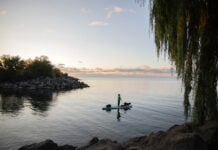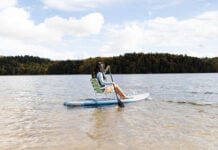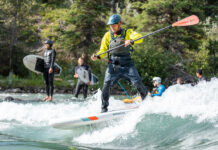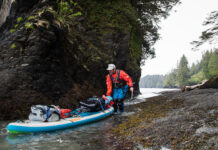“Waves were the playing field. They were the goal. They were the object of your deepest desire and adoration. At the same time, they were your adversary, your nemesis, even your mortal enemy. The surf was your refuge, your happy hiding place, but it was also a hostile wilderness — a dynamic, indifferent world.”
Two years ago, these words, written by William Finnegan in his Pulitzer Prize-winning surfing memoir Barbarian Days, would have meant nothing to me. I was born and raised in Toronto, Ontario, and have spent the past 20 years living in a pair of cities, Edmonton and now Ottawa, far from any ocean.
To me, waves were not a dynamic object of desire; they were entirely foreign, traversed only on big boats and entered only on brief forays from the beach. Surfing, meanwhile, was as alien and abstract as astrophysics or Sunday school—a passion or a pastime for people whose circles rarely crossed mine. Then I got my first standup paddleboard, and over a couple summers progressed from lakes and flatwater rivers to whitewater and ocean touring. And then I caught a wave.
Finnegan’s formative experiences as a surfer were in California and Hawaii. I first tasted the thrill at Sandbanks Provincial Park, near the tip of a headland that juts into Lake Ontario just west of Kingston, three hours by car from home. Sandbanks—site of the world’s largest bay mouth barrier dune formation—has clear water and long sandy beaches. When a swell rolls in or the wind kicks up, the waves are rideable. Even the ankle biters. Especially on a paddleboard.
During a late-September heat wave, no wetsuit required, on my 10-foot hardshell, I pivoted onto a three-foot breaker and rocketed back toward the shore. And then did it again. And again.
Despite the speed, time slowed while balanced on the board. I understood, waiting for the next set, looking over my shoulder and squinting into the sun, why people devote their lives to chasing this intoxicating alchemy of energy and serenity; why I, a middle-aged geographically challenged dad on a family camping trip, felt suddenly compelled to do the same.
My next session, a month later at the same beach, with wind gusts topping 60 miles an hour, revealed the extent of those challenges. I had to battle into the onshore wind to reach the water from the parking lot, but it was the only surf in the forecast during a holiday weekend visit to a nearby cabin, and those brief seconds of flying atop the water were worth it.
A few factors prevented me from relocating to a tropical surf break for a month to get the hang of my new obsession. My family. My job. My bank account. Throughout the ensuing winter, watching surfing videos online and reading about the sport stoked an inexorable yearning to get back onto a wave.
When the ice on the rivers that run through Ottawa broke apart, I completed my now-traditional spring ritual: an after-work, one-way, 10-kilometer paddle down the Rideau River on my inflatable SUP, propelled by the current through a patch of class I bumps, and then a rush-hour bus ride home. It feels defiant and deeply satisfying to be standing amid commuters with a paddle in hand and a PFD strapped to an oversized pack. Yet still, it wasn’t enough.
Salvation came a couple weeks later on the Ottawa River. I had heard about locals who river surfed on standing waves that rise with the freshet. Kayakers, conventional surfers and now SUP surfers congregate at Bate Island, near the middle of the river, where an eddy snug tight to a retaining wall provides access to a series of waves that are rideable for maybe two months every spring. I joined the lineup on a crisp Saturday afternoon wearing a borrowed too-thin wetsuit and asked the only other paddleboarder for advice.
“There’s an extra helmet in my car,” he said. “Go get it and put it on.”
When my protective new pal crossed the eddyline and slipped onto the wave, he made it look comically easy, cutting and sliding back and forth across the face for as long as he wanted to remain upright. A half dozen prone surfers did the same. My turns were shorter. Within a second or two, I’d be down and tumbling through the rest of the rapids. When I finally managed to catch the wave for about half a minute, either the next day or the one after that—the sessions blurred together, one turbulent ice bath after another—I knew river surfing would also be part of my future.
Summer is usually considered prime paddleboarding season, but when water levels dropped and the wave at Bate Island disappeared, it felt like I had lost a friend. A really frustrating friend, mind you—the type who might not be good for you, but you just can’t stay away from. Fortunately, trips over the next few months took me to both coasts.
In Newfoundland, a tip from a local sent me to a rocky harbor at dawn to catch the incoming swell. I hoped to build on that success last fall in Tofino, with, for the first time, a proper SUP surf board and, probably more important, proper coaching. And though I did get some waves, the longer I stayed on the water, the more I fell and failed. Which reminded me of a saying I’ve heard about complicated places. Visit for one day and the country will be totally confusing. After a month, you’ll start to figure it out. After a year, you’ll be baffled again. That captures my relationship with surfing. I’m in head over heels, often literally, and can’t wait for more.
Ottawa-based writer Dan Rubinstein loves all forms of paddleboarding. His first book, Born to Walk: The Transformative Power of a Pedestrian Act, was published in 2015, and he’s now working on a non-fiction book about paddleboarding.
“The sea, once it casts its spell, holds one in its net of wonder forever.” —Jacques Cousteau | Feature photo: Keenan Bush








